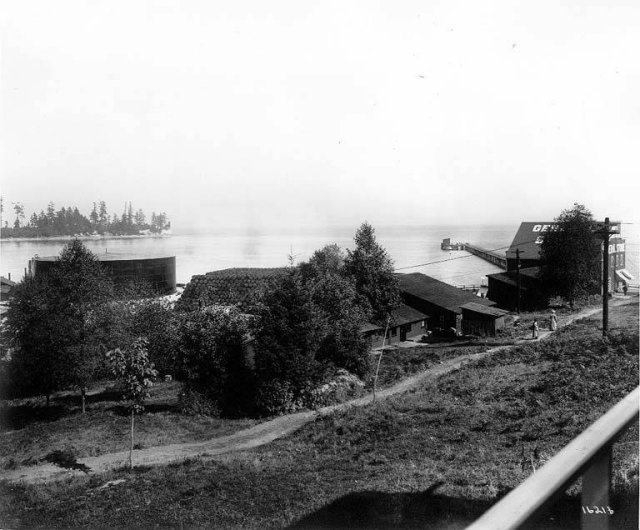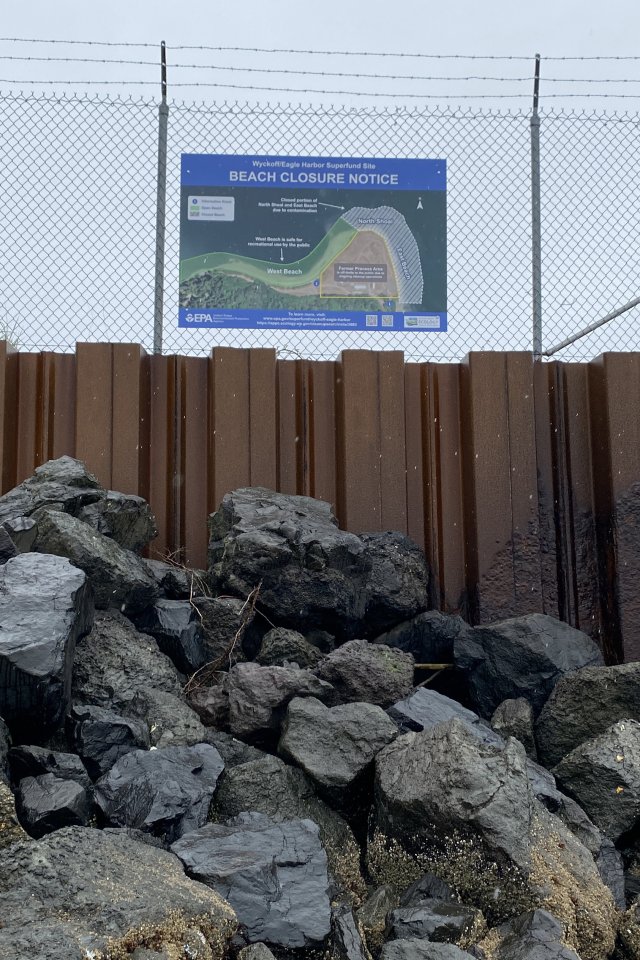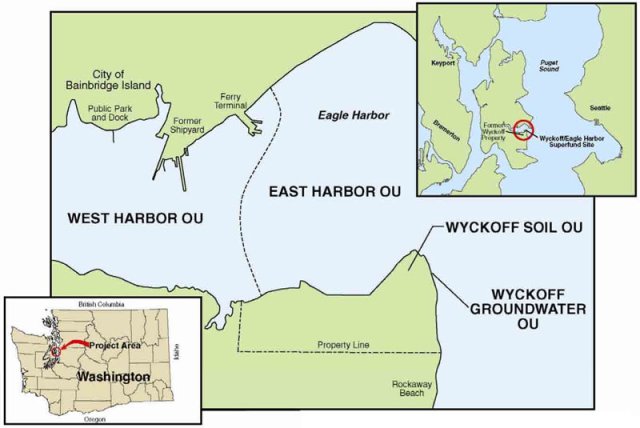Site History

On this page:
About the Site
The Wyckoff/Eagle Harbor Superfund site is on the east side of Bainbridge Island in central Puget Sound in Washington. The former Wyckoff wood-treating facility, located at the mouth of Eagle Harbor on Bainbridge Island, forms part of the site. The facility operated from 1903 until 1988, contaminating soils and groundwater with creosote.
EPA added Eagle Harbor to the Superfund National Priorities List in 1987, when environmental investigations revealed extensive contamination in soils, groundwater, and in the sediment on the bottom of Eagle Harbor.
Health Risks
The cleanup work completed so far has controlled or eliminated much of the risk at the site. However, soil and groundwater in the upland portion of the former Wyckoff wood treating facility remain contaminated with creosote and other wood treating chemicals. The site is fenced to prevent people from coming into contact with contaminated soils.
Groundwater is recovered through nine extraction wells and treated in an on-site treatment plant prior to discharge into Puget Sound. The groundwater extraction system and a metal sheet pile wall around the edge of the site prevent contaminants from moving into Eagle Harbor.

The beaches to the east (East Beach) and north (North Shoal) of the wood-treating facility are still contaminated with creosote. EPA and the Washington Department of Ecology advise that people avoid these areas. Beach closure notices are posted to discourage beach use, and the beaches are closed to shellfish harvesting.
Learn more about the contamination at East Beach and North Shoal and how to safely enjoy the beaches that are open to the public.
About creosote and other site contaminants
Creosote is a chemical used to treat wooden railroad ties, utility poles, and pier pilings. It is an oily petroleum-based product with a distinctive odor. On bare skin, creosote can cause chemical burns. More information about creosote is available from the Centers for Disease Control.
Creosote contains polycyclic aromatic hydrocarbons (PAHs), which are chemicals found in oil, coal and tar. Some of the PAHs found in creosote may cause cancer. More information about PAHs is available from the Centers for Disease Control.
Besides creosote, pentachlorophenol (PCP), and mercury are contaminants of concern at the site.
Cleanup History
EPA's role
EPA is the lead agency for this project, with the support and cooperation of numerous other government agencies and organizations, including the U.S. Army Corps of Engineers.
The Washington Department of Ecology operates a groundwater extraction and treatment system at the former Wyckoff wood treating facility that helps to contain the contamination, preventing it from moving into Eagle Harbor.
The Suquamish Tribe's treaty-protected fishing area includes Eagle Harbor, and the Tribe has been working for decades to restore habitat for fish and shellfish in Eagle Harbor.
Other federal and state agencies act on behalf of the public to protect and restore natural resources in and around Eagle Harbor and advise EPA on contaminant impacts and cleanup plans. The Elliott Bay Natural Resources Damages Trustee Council has completed a project to restore eelgrass in Eagle Harbor.
Cleanup areas
EPA divided the site into three cleanup areas, or "operable units." Below is a summary of each cleanup area and a link for more information.
- East Harbor Sediment Cleanup Area (also called East Harbor Operable Unit, or OU1): Includes about 100 acres of sediment on the bottom of Eagle Harbor that became contaminated with creosote and other chemicals released from the former Wyckoff wood treating facility.
- Wyckoff Facility Soils and Groundwater Cleanup Area (also called the Soil and Groundwater Operable Units, or OU2/OU4): Located on the south side of Eagle Harbor and includes soil and groundwater that became contaminated during decades of wood treating operations at the former Wyckoff facility.
- West Harbor Soils and Sediment Cleanup Area (also called the West Harbor Operable Unit, or OU3): Located on the north side of Eagle Harbor, and not associated with the former Wyckoff wood-treating facility. Site of a former shipyard which became contaminated with mercury and other metals.
Cleanup timeline
Over the years, extensive cleanup actions have been completed in all four of the site’s operable units (see "Cleanup Areas" above). The operable units are monitored regularly to ensure the cleanup actions continue to be protective. The major actions taken at the site are:
- 1990: Groundwater treatment plant installed (OU4)
- 1994: Time-critical removal action of soil and sludge completed (OU2)
- 1994: Phase I subtidal sediment cap completed (OU1)
- 1997: Sediment dredging and capping completed (OU3)
- 2000: Phase II subtidal sediment cap near the facility completed (OU1)
- 2001: Perimeter sheet pile wall completed (OU2/4)
- 2001: Phase III intertidal beach cap completed (OU1)
- 2003: Thermal pilot test completed (OU2/4)
- 2008: Exposure barrier system intertidal sediment cap completed (OU1)
- 2010: Construction of new (and current) groundwater treatment plant completed (OU2)
- 2012: Ecology began operating the groundwater extraction and treatment system at the former Wyckoff facility (OU2)
- 2017: Subtidal cap repair completed (OU1)
- 2020: Tree removal and access road improvements (OU2/4)
Site Redevelopment
The City of Bainbridge Island and the Bainbridge Island Metro Park & Recreation District are the property owners at the Wyckoff/Eagle Harbor Superfund site. Most of the site has already been incorporated into Pritchard Park. When cleanup activities are complete, the intent is for the site to be converted into a public park.
EPA’s Superfund Redevelopment Initiative funding helped plan Pritchard Park, now a popular 50-acre recreational amenity for the local community.

